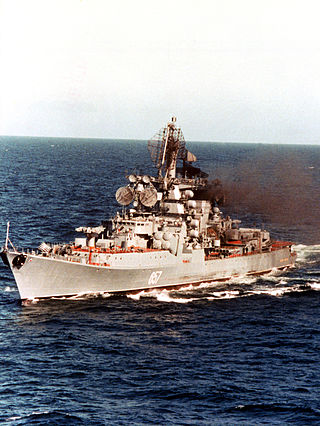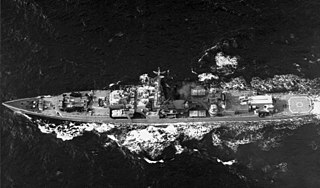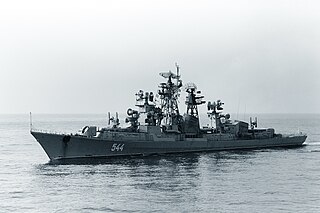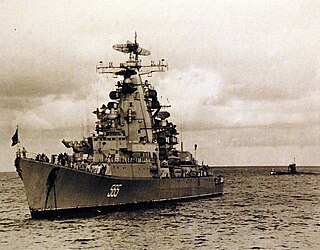
The Udaloy class, Soviet designation Project 1155 Fregat and Russian designation Project 11551 Fregat-M, are series of anti-submarine guided-missile destroyers built for the Soviet Navy, seven of which are currently in service with the Russian Navy. Twelve ships were built between 1980 and 1990, while the thirteenth ship built to a modified design, known as Udaloy II class, followed in 1999. They complement the Sovremenny-class destroyers in anti-aircraft and anti-surface warfare operations. The codename Udaloy comes from an archaic Russian adjective удалой, meaning daring or bold.

The Kresta II class, Soviet designation Project 1134A Berkut A, was a class of guided missile cruiser built by the Soviet Union for the Soviet Navy. The NATO lists the class as "cruisers" mainly due to the Metel anti-ship missile system capable to strike not only submarines but also surface vessels.

The Admiral Gorshkov class is a class of frigates of the Russian Navy. The ships are being built by the Severnaya Verf in Saint Petersburg at a cost of $250 million per ship. The class, designated by Russia as Project 22350, was designed by the Severnoye Design Bureau and incorporates use of stealth technology. As of August 2020, ten vessels have been ordered for delivery by 2027. The lead ship of the class, Admiral Gorshkov, was commissioned on 28 July 2018.

Kronstadt was a Project 1134A Kresta II-class cruiser of the Soviet Navy, named for the Kronstadt naval base. The first ship of her class, the ship served during the Cold War, from 1969 to 1991. She served with the Northern Fleet, with her shakedown cruise being through the Mediterranean Sea. After colliding with a destroyer in 1975, she spent five years being repaired and modernized. She was decommissioned in 1991 before being sold for scrap two years later due to reduced naval funding and deteriorating conditions.

Zadornyy was a Project 1135 Burevestnik-class guard ship or Krivak-class frigate that served with the Soviet and Russian Navies. Displacing 3,200 tonnes full load, the vessel was built around the Metel anti-submarine missile system. Zadornyy was launched on 25 March 1979 in Leningrad, the last of the class to be built by the A.A. Zhdanov shipyard, and served with the Northern Fleet. After taking part in exercises Avangard-81, Sever-81 and Okean-83, and cruising as far as Havana, Cuba, the vessel was upgraded between 11 June 1990 and 23 May 1995 with missiles that added anti-ship capability. While serving with the Russian Navy, the ship took part in joint exercises with frigates of the Royal Navy, including a commemoration of the first Arctic convoy of the Second World War with HMS Campbeltown. After more than twenty-five years service, the ship was decommissioned on 3 December 2005.

Admiral Isakov was a Kresta II-class cruiser of the Soviet Navy and briefly of the Russian Navy, named for Soviet admiral Ivan Isakov. The second ship of her class, she served mostly during the Cold War from her commissioning in 1970.
Admiral Nakhimov was a Project 1134A Kresta II-class cruiser of the Soviet Navy, named for Russian naval commander Pavel Nakhimov. The third ship of her class, the ship served during the Cold War, from 1971 to 1991. She served with the Northern Fleet for the duration of her career, often operating in the Atlantic and the Mediterranean in order to show the flag. She was decommissioned in 1991 before being sold for scrap due to reduced naval funding in 1993.

Admiral Zozulya was the lead ship of the Soviet Navy Project 1134 Admiral Zozulya-class Large Anti-submarine Ship also known as the Kresta I Class guided missile cruisers. Launched in 1965, the ship was reclassified a Large Rocket Ship in 1977. Admiral Zozulya served primarily in the Northern Fleet during the Cold War, transferring to the Russian Navy at the dissolution of the Soviet Navy, and was decommissioned in 1994 after nearly thirty years of service.

Vitse-Admiral Drozd was the third ship of the Project 1134 Berkut Large Anti-submarine Ships built for the Soviet Navy, also known as the Kresta I-class or Admiral Zozulya-class guided missile cruisers. The vessel was launched on 18 November 1966 and served with the Baltic Fleet through the 1970s and 1980s. As well as taking part in naval exercises in the Atlantic, the ship assisted in the rescue of the crew of the stricken submarine K-19 in March 1972. Subsequently, the ship was visited by Sergey Gorshkov, commander of the Soviet Navy. The vessel was reclassified a Large Rocket Ship in 1977 to reflect its multi-purpose capability. After an upgrade in 1981, Vitse-Admiral Drozd continued to operate in the Mediterranean Sea and Atlantic Ocean until being decommissioned on 1 July 1990. The ship was sent to India to be scrapped in March 1992 but sank en route.

Admiral Makarov was a Project 1134A Berkut A class cruiser of the Soviet Navy and briefly of the Russian Navy. The fourth ship of her class, the ship served mostly during the Cold War, from 1972 to 1992. She served with the Northern Fleet for the duration of her career, often operating in the Atlantic and the Mediterranean in order to show the flag, and was refitted between 1983 and 1985. She was decommissioned in 1992 due to deteriorating conditions which reduced naval funding prevented from being addressed before being sold for scrap in 1994.

Marshal Voroshilov was a Project 1134A Berkut A class cruiser of the Soviet Navy, which briefly became part of the Russian Navy after being renamed Khabarovsk in 1991. The fifth ship of her class, the ship served mostly during the Cold War, from 1973 to 1992.

Admiral Oktyabrsky was a Project 1134A Berkut A -class cruiser of the Soviet Navy, which briefly became part of the Russian Navy. The sixth ship of her class, the ship served mostly during the Cold War, from 1973 to 1993.

Marshal Timoshenko was a Project 1134A Berkut A class cruiser of the Soviet Navy. The eighth ship of her class, the vessel served during the Cold War with the Northern Fleet, often operating in the Atlantic Ocean but also travelling to various ports in the Mediterranean and Red Seas. The cruiser was taken out of service to be modernised in 1988 but a lack of funds meant the work was not completed. Instead Marshal Timoshenko was decommissioned in 1992.

Vasily Chapayev was a Project 1134A Berkut A class cruiser of the Soviet Navy named for the naval commander Vasily Chapayev. The Project 1134A vessels were envisaged as a counter to the attack and ballistic missile submarines operated by the members of NATO. To that end, they were equipped with two KT-106 quadruple launchers for eight 85R anti-submarine missiles in the URPK-3 Metel system. The ninth ship of the class, Vasily Chapayev was launched in 1974 and served during the Cold War with the Pacific Fleet. Based at Vladivostok, the ship travelled extensively in the Indian and Pacific Oceans, visiting a large number of friendly ports in Angola, Ethiopia, India, Mozambique and Yemen. In 1978 and 1979, the vessel formed part of a Soviet flotilla, including the Project 68bis cruiser Admiral Senyavin, that supported Vietnam in the aftermath of the Sino-Vietnamese War. In 1982, Vasily Chapayev was allocated to support the BOR-4 spaceplane programme, and two years later, the vessel participated in a search for a US Navy submarine that was suspected of being near the Kamchatka Peninsula in the Russian Far East. In 1985, the ship took part in a simulated joint operations attack on the US base at Pearl Harbor that involved the coordinated use of aircraft, ships and submarines. During the following year, the vessel took part in first joint exercises that involved both the Soviet and North Korean Navies. Taken out of active service in 1992, Vasily Chapayev was decommissioned and transferred to be broken up in 1993.

Sposobny was a Project 61 destroyer of the Soviet Navy, which briefly became part of the Russian Navy. The ship served during the Cold War from 1971 to 1989.

Admiral Isachenkov was a Project 1134A Berkut A large anti-submarine ship of the Soviet Navy. The seventh ship of the class, the vessel was launched in 1972 and served during the Cold War with the Northern Fleet, often operating in the Atlantic Ocean but also travelling to various ports in the Mediterranean Sea. The ship acted as flagship for the Minister of Defence, Marshal of the Soviet Union Andrei Grechko, during the exercise Okean-75 in 1975 and operated alongside the newly launched Project 1143 Krechyet aircraft carrier Kiev in 1977 and 1978. The ship also shadowed the NATO aircraft carriers HMS Ark Royal, USS Independence and USS John F. Kennedy. The cruiser was taken out of service for repairs in 1981 and substantially upgraded with new weapons and communications systems, re-entering service in 1982. With the end of the Cold War, the Navy reassessed its need for large warships and, after a career stretching nearly twenty years, Admiral Isachenkov was decommissioned in 1992 and sold to be broken up.

Vladivostok was the second Soviet Navy Project 1134 Admiral Zozulya-class Large Anti-submarine Ship also known as a Kresta I guided missile cruiser. Launched on 1 August 1966, the ship was reclassified a Large Rocket Ship on 3 August 1978 to reflect the wide-ranging capability of the vessel. Serving primarily in the Pacific Fleet during the Cold War, Vladivostok took part in exercises and tours that demonstrated Soviet naval power in the Indian and Pacific Oceans. The ship played a part at a number of points of potential escalation in the Cold War, including the Indo-Pakistani War of December 1971 and the collision between the aircraft carrier Kitty Hawk and the submarine K-314 in March 1984. Vladivostok was taken out of service to be modernised and updated on 28 September 1988 but there were insufficient funds to complete the work. Instead the ship was decommissioned on 19 April 1990 and, the following January, sold to an Australian company to be broken up.

Admiral Kharlamov was an Udaloy-class destroyer of the Russian Navy. It was named after admiral Nikolay Kharlamov.

Razyashchiy was a Project 1135 Burevestnik-class Large Anti-Submarine Ship or Krivak-class frigate of the Soviet Navy. Displacing 3,200 tonnes full load, the vessel was built around the Metel anti-submarine missile system. Launched on 22 July 1974, Razyashchiy joined the Pacific Fleet of the Soviet Navy. While serving in the Arabian Sea, in 1983, Razyashchiy suffered minor hull damage from colliding with the destroyer USS Fife while approaching a US fleet. The ship also undertook visits to Port Louis, Mauritius, and Danang, Vietnam, to, among other objectives, enhance the relationships between these countries and the Soviet Union. In 1991, the vessel was transferred to the newly-formed Russian Navy. After nearly twenty years of service, however, Razyashchiy was in a poor state and so was decommissioned on 29 October 1992 and sold to be broken up on 6 October 1994.


















